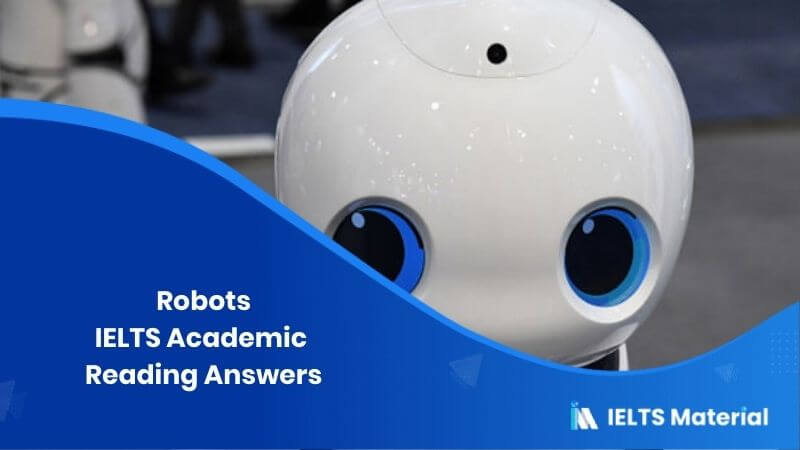IELTS Academic Reading ‘Robots’ Answers

Limited-Time Offer : Access a FREE 10-Day IELTS Study Plan!
The Academic passage ‘Robots’ is a reading passage that appeared in an IELTS Test. Ideally, you should not spend more than 20 minutes on a passage. Since questions get repeated in the IELTS exam and contains some of the IELTS reading question types, these passages for ideal for practice.
If you are interested in familiarising yourself with all the question types, don’t hesitate to take an IELTS reading practice test.
The question types found in this passage are:
Matching Headings
In Matching Headings question, a list of headings will be given and you are asked to match these headings with a paragraph in the passage. You should read the headings before you begin reading the text. To get the correct answer, you have to read the complete paragraph and not just stop with the first few lines of the paragraph. There will also be many other headings that are not related to any of the paragraphs given in the passage, in such cases, try to identify those types of headings too.
Yes/No/Not Given Questions
Similar to the True/False/Not given questions, Yes/No/Not given questions also have various statements. But here you are asked to agree or disagree with the statement based on the opinion of the author.
Summary Completion
In Summary Completion question, you will be provided with a summary of information from a text, and there will be a few gaps. You will either get a list of words to be filled in the gaps or you could be asked to find answers from the reading passage. You will have to insert a few words from the text into the gaps. All of the information in the summary will also be available in the reading text. However, they will be using paraphrasing and synonyms. Thus, you cannot expect to find the exact words.
Robots






Answers
Unlock Answer
Signup/Login and get access to the answers
The answers with explanations are given below
14 Answer: viii
Question Type: Matching Headings
Answer location: Paragraph A, line 1
Answer explanation: Paragraph A specifies that the modern world is increasingly populated (the numbers are increasing) by quasi-intelligent gizmos (which refers to robots – the term was coined by the Czech playwright in 1920) whose presence we barely notice but whose creeping ubiquity (the presence of the robots are increasing quietly) has removed much human drudgery (by taking responsibility of the hard, dull work, the robots are becoming an important part of human life). Hence, the answer is viii (Robots have quietly infiltrated our lives).
15 Answer: vi
Question Type: Matching Headings
Answer location: Paragraph B, line 1
Answer explanation: Paragraph B suggests that other innovations promise to extend the abilities of human operators. Due to the incessant miniaturisation of electronics and micromechanics, there are robot systems that can perform some kinds of brain and bone surgery with submillimeter accuracy – far greater precision than highly skilled physicians can achieve with their hands alone. At the same time, techniques of long-distance control will keep people even farther from hazard. This means that with the help of robotics humans can perform more complicated operations and can avoid accidents which heightens human skills. Hence, the answer is vi (Human skills have been heightened with the help of robotics).
16 Answer: vi
Question Type: Matching Headings
Answer location: Paragraph C, last line
Answer explanation: Paragraph C intimates that if robots are to reach the next stage of labour-saving utility, they will have to operate with less human supervision and be able to make at least a few decisions for themselves. Despite a spasm of initial optimism in the 1960s and 1970s, when it appeared that transistor circuits and microprocessors might be able to perform in the same way as the human brain by the 21st century, researchers lately have extended their forecasts by decades if not centuries. So, the original predictions made by the researchers on the developmental works of the robots have been revised and extended by decades. Hence, the answer is ix (Original predictions have been revised).
17 Answer: iv
Question Type: Matching Headings
Answer location: Paragraph D, line 3
Answer explanation: Paragraph D relates that the human mind can glimpse a rapidly changing scene and immediately disregard the 98 percent that is irrelevant, instantaneously focusing on the woodchuck at the side of a winding forest road or the single suspicious face in a tumultuous crowd. The most advanced computer systems on Earth can’t approach that kind of ability, and neuroscientists still don’t know quite how we do it. So, the robots cannot yet distinguish between relevant and irrelevant details. Hence, the answer is iv (There are judgements that robots cannot make).
18 Answer: i
Question Type: Matching Headings
Answer location: Paragraph E, line 1
Answer explanation: Paragraph E lets out the fact that as information theorists, neuroscientists, and computer experts pool their talents, they are finding ways to get some lifelike intelligence from robots. One method renounces the linear, logical structure of conventional electronic circuits in favour of the messy, ad hoc arrangement of a real brain’s neurons (the brain functions are being observed and taken into account). As these observations are used in the robots, they can ‘teach’ themselves by a system of feedback signals that reinforce electrical pathways that produce correct responses and wipe out connections that produce errors (which is success as eventually the net wires itself into a system that can pronounce certain words or distinguish certain shapes). Hence, the answer is i (Some success has resulted from observing how the brain functions).
19 Answer: iii
Question Type: Matching Headings
Answer location: Paragraph F, line 1
Answer explanation: Paragraph F explains that researchers (scientists) are struggling to fashion (examine) a more natural relationship between people and robots (humanistic possibilities) in the expectation that some day machines will take on some tasks now done by humans in, say, nursing homes. Hence, the answer is iii ( Scientists are examining the humanistic possibilities).
20 Answer: YES
Question Type: Yes/No/Not Given Question
Answer location: Paragraph A, line 6
Answer explanation: Paragraph A refers to the fact that the scope of uses (our current uses for robots) of robots were envisioned (successfully predicted) by Karel Capek, the Czech playwright who coined the term ‘robot’ in 1920 (the word ‘robota’ means ‘forced labor’ in Czech). As the statement agrees with the information, the answer is YES.
21 Answer: NOT GIVEN
Question Type: Yes/No/Not Given Question
Answer location: Paragraph B, last line
Answer explanation: At the end of paragraph B, the author writes that in 1994 a ten- foot-tall NASA robotic explorer called Dante, with video-camera eyes and with spider like legs, scrambled over the menacing rim of an Alaskan volcano while technicians 2,000 miles away in California watched the scene by satellite and controlled Dante’s descent. This is the only reference to Dante, the robot in the passage. As there is no mention if Dante had saved lives, the answer is NOT GIVEN.
22 Answer: YES
Question Type: Yes/No/Not Given Question
Answer location: Paragraph B, line 2
Answer explanation: Paragraph B indicates that due to the continuous development and miniaturisation of electronics and micromechanics, there are robot systems that can perform some kinds of brain and bone surgery with submillimeter accuracy. As a result, these robots can make fine visual judgements with more precision than highly skilled physicians. As the statement agrees with the information, the answer is YES.
23 Answer: NO
Question Type: Yes/No/Not Given Question
Answer location: Paragraph D, line 2
Answer explanation: Paragraph D communicates that the human brain’s roughly one hundred billion neurons are much more talented and human perception far more complicated. They have built robots that can recognise the misalignment of a machine panel by a fraction of a millimeter in a controlled factory environment. But the human mind can glimpse a rapidly changing scene and immediately disregard the 98 percent that is irrelevant. The most advanced computer systems on Earth can’t approach that kind of ability, and neuroscientists still don’t know quite how we do it. So, these statements prove that in spite of continuous development in the robots, they are yet to replicate the internal workings of the brain. As the statement contradicts the information, the answer is NO.
24 Answer: NOT GIVEN
Question Type: Yes/No/Not Given Question
Answer location: Paragraph F, line 7
Answer explanation: In paragraph F, it is given that the Japanese robot is designed to detect emotions in the person it is ‘looking at’ by sensing changes in the spatial arrangement of the person’s eyes, nose, eyebrows, and mouth. It compares those configurations with a database of standard facial expressions and guesses the emotion. But the author did not write whether this robot is the most advanced or not. As there is no information about the Japanese having the most advanced robot systems, the answer is NOT GIVEN.
25 Answer: video camera
Question Type: Summary Completion
Answer location: Paragraph F, line 3
Answer explanation: Paragraph F states that experiments at the Science University of Tokyo in Japan have created a prototype ‘face robot’ – a life-size, soft plastic model of a female head with a video camera imbedded (planted) in the left eye (in its head). It is created to observe humans and make people feel comfortable around robots. Hence, the answer is ‘video camera’.
26 Answer: database
Question Type: Summary Completion
Answer location: Paragraph F, 2nd last line
Answer explanation: Paragraph F points out that the Japanese robot compares the configurations of spatial arrangement of the person’s eyes, nose, eyebrows, and mouth with a database of standard facial expressions (typical ‘looks’ of humans) and guesses the emotion (decide what emotion the person is feeling). Hence, the answer is ‘database’.
27 Answer: (tiny/small) pressure pads
Question Type: Summary Completion
Answer location: Paragraph F, last line
Answer explanation: Paragraph F brings out the fact that after comparing the configurations with a database of standard facial expressions and guessing the emotion, the robot uses an ensemble of tiny pressure pads to adjust its plastic face into an appropriate emotional response. So, the robot changes its own expression using a number of small pressure pads and then responds to the changes in human facial expressions after comparing it with the one present in the database. Hence, the answer is ‘(tiny/small) pressure pads’.
Check More IELTS Reading Answers
Also check :
Practice IELTS Reading based on question types

Start Preparing for IELTS: Get Your 10-Day Study Plan Today!
Explore other Reading Topics

Janice Thompson

Janice Thompson
Recent Articles

Kasturika Samanta

Kasturika Samanta

Janice Thompson







Post your Comments